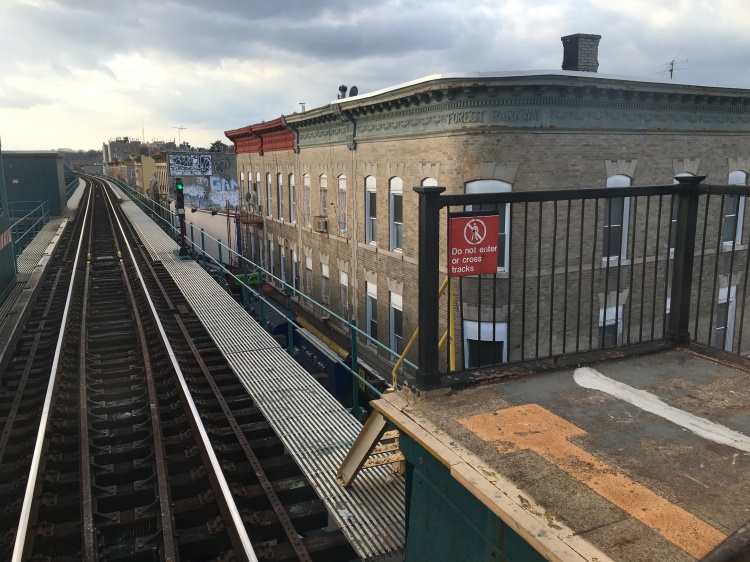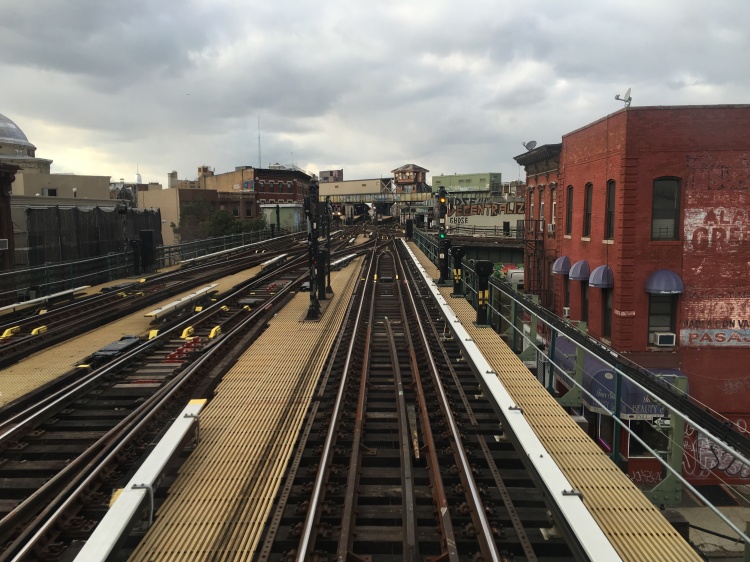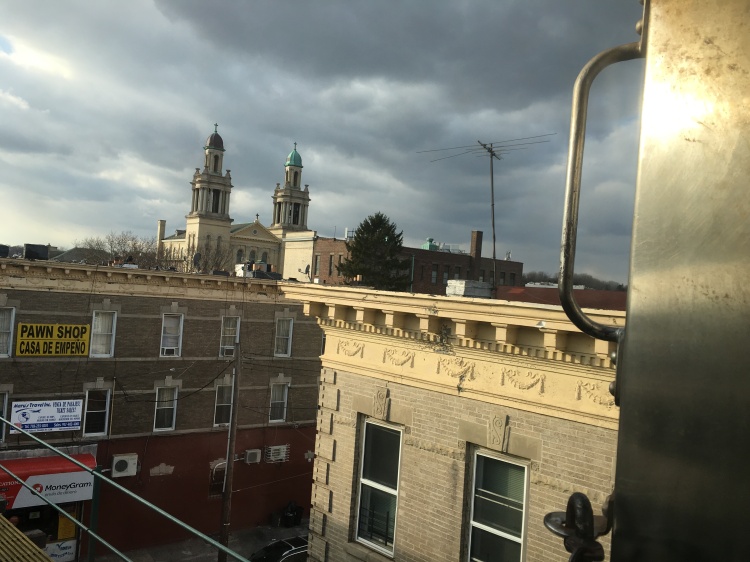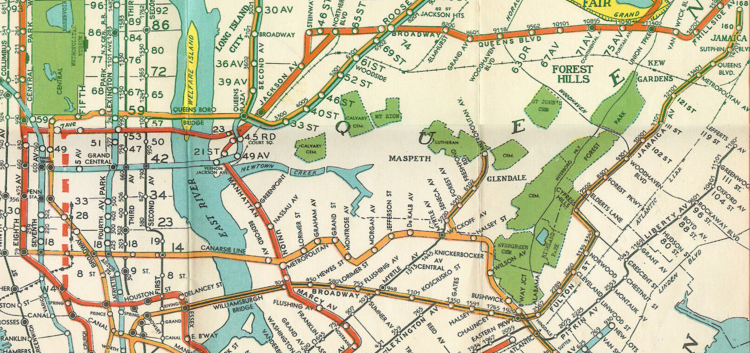Built in the 1870s, the Third Avenue IRT was the above ground cousin of the Lexington Avenue IRT subway that runs completely underneath the sidewalks in Manhattan. Towards the end of its days in the 1960s, the remnant of the Third Avenue line in the Bronx was finally designated as the 8 train. However, back in the 1950s, the last decade of service on Third Avenue in Manhattan, the trains were only marked by destination – southbound to City Hall, northbound to The Bronx (Bronx Park or 241th Street).
Vintage elevated lines are a disappearing breed of mass transit. The Third Avenue El was derided as a noisy eye-sore and was hurriedly demolished to placate real estate developers who were eager to rebuild Midtown East. The stated intention was to replace it with the new Second Avenue subway which, unfortunately, was delayed more than 60 years and is still not yet in service today!
RIDING ELS
I commuted to summer school once on an El, line 6 of the Paris Metro, otherwise known as the Étoile-Nation line. About half of it runs above ground. That section was part of my commute from Denfert-Rochereau to Passy. After Pasteur Station, the train climbed out of the tunnel onto a viaduct and gave tremendous views of the tony left bank neighborhood. In fact the station serving the Eiffel Tower – Bir-Hakeim – is an elevated station on this line (see my post LOOKIN’ FOR THE EIFFEL TOWER). Interestingly, the same technology built both structures.
 The experience of riding an El train is much better than a subway. For one thing, there’s nothing to see out the window into the darkness of the underground. There are other hazards. Riding the Piccadilly Line in London, for example, between the Green Park and Piccadilly Circus stations, passengers can experience vertigo as the train noticeably speeds down the dipping and up the rising tunnel with no visual references out the window.
The experience of riding an El train is much better than a subway. For one thing, there’s nothing to see out the window into the darkness of the underground. There are other hazards. Riding the Piccadilly Line in London, for example, between the Green Park and Piccadilly Circus stations, passengers can experience vertigo as the train noticeably speeds down the dipping and up the rising tunnel with no visual references out the window.
Views from the El? It’s kinda like what a resident in an ugly building sees out the window. Too bad for everyone else who has to live next to the unsightly ziggurat. Better to be on an El than not.
The Third Avenue El was hardly as glamorous as the Étoile-Nation line. The trestle carrying the trains in New York were bare steel supports as opposed to the decorated masonry of the Paris line. However, in New York, curiously, certain things like building names and advertisements painted on the walls of buildings were meant to be seen from elevated lines.

Notice the name “Forest Parkway” on the building clearly visible from the train and platform.
YESTERDAY AND TODAY
The essence of an elevated line is to be a steel ribbon that cuts through the hearts and cores of large cities. As research for this story, I retraced my Dad’s daily commute in the late 1930s from his home in Jamaica to Cooper Union on St. Mark’s Place. It was an hour and half door to door on two lines—both of them Els.
Dad’s neighborhood station on the Jamaica El was Sutphin Avenue. It was demolished in 1977 when the Archer Avenue underground extension was built, linking the E and J trains to the Long Island Rail Road and the JFK Skytrain. Today Sutphin Avenue is a completely modern underground station. The next stop in towards Manhattan, the 112th Street Station, and the rest are still on the original El. This means that one can still ride a 19th century elevated line in New York!

Now designated the J train, it winds its way past church steeples and the Cypress Hills cemetery (together with 10 others forming a huge burial complex on the ridge of the aforementioned Cypress Hills). It eventually cruises through Williamsburg, past the Domino Sugar Factory, over the Williamsburg Bridge, goes underground at the Essex Street Station (home of the future Lowline Park), and then The Bowery. It was here that Dad would change for another El – the Third Avenue.

THE TRANSFER
The Bowery station is currently one of the most underused stations in the entire NYC transportation network. Back in the 1930s and 1940s, however, this station was a major interchange between the Jamaica/Broadway (Brooklyn) El and the Third Avenue El at the adjacent Grand Street Station (demolished in 1955). Today, two stairwells remain in The Bowery Station – the north stairwell is the present day entrance to the station. The south stairwell is still there but no longer serves as an exit to the street above or to the long gone Grand Street Station of the Third Avenue El. However, you can peer up those decrepit stairs through the bars and see where my Dad (and millions others) climbed up to make the connection.
Here’s a picture of those abandoned stairs today, visible through locked iron gates.

Did he change trains or walk through the Bowery neighborhood? I am not sure; if the connection was free, I’m sure he would have made the connection. Unfortunately, the transit maps of the era are not clear on this point.

Would he have wanted to walk from the Bowery? Today it’s an antiquated boulevard populated with lighting shops and one or two trendy Parisian bistros. But in the last century?
I remember when Dad and his new bride Gloria were building Lindal cedar pre-fabricated homes in McAfee, New Jersey and Shinnecock Hills, Long Island in the early 1970s. For lighting fixtures, Dad sent Gloria down to The Bowery to make purchases at wholesale cost. It was a nasty neighborhood however; memorable for aggressive drunk panhandlers. If not accosting passersby, whether on foot or in automobiles, they could be seen sprawled out on the sidewalks, empty pint bottles littered every which way.
![bowery-new-york-city[1].jpg](https://thebernardolcottstory.files.wordpress.com/2016/01/bowery-new-york-city1.jpg?w=750)
The Bowery had already been in decline by the time the Third Avenue El darkened the streets below in the 1870s. It was no better in the late 1930s. If Dad switched for the Third Avenue El to avoid the schickers and schmucks below, who could blame him?
Dad himself told me about riding the Els, and the Third Avenue one in particular. When he was a student at Cooper Union as well as a new graduate afterwards, the chic neighborhood of the time was Third Avenue in the East 50s – a short ride up the Avenue from Cooper Union and his connecting line, the Jamaica El. Grabbing drinks and grub at swank eateries like PJ Clarke’s, Toots Shor, or the 21 Club was de rigeur for the smart set. Unlike London or Paris however, the moneyed classes eschewed the New York subways (or El) – they considered it strictly for the hoi polloi. This distinction continues up to the present day, and is probably related to the difference on maintenance between the systems in all three cities (meaning the spending is a lot less in New York).
While patrons from the silk stocking district uptown would take taxis down to these hot spots, Dad would ride the El up. He liked the El as a passenger. On sweltering summer days, he would tell me, he would stand on the outside platform at the end of each car, and let the breeze cool him off. In 1949, he probably rode it to a party one Saturday night where he met his first wife.
Next week, Part 2, featuring an art house film of the Third Avenue El!

As a bit of a historic train buff, I really enjoyed this installment. Looking forward to the next!
LikeLiked by 1 person
I don’t know why, but I am intrigued by them also. Thanks for commenting!
LikeLike
Had no idea about this! 53rd and 3rd is more famous than I thought: https://www.youtube.com/watch?v=3qcMjKxt-dE
LikeLiked by 1 person
In the 1970s, this was a scandalous area roamed by “chicken hawks”…
In any event, the Ramones rule. I caught them in a pizza parlor in Pittsburgh (PPP) around 1977. Off the hook!
LikeLiked by 1 person
Hello readers !
I lived and grew up along the Manhattan 3rd Avenue EL on the upper East Side adjacent to an EL station.
I rode the EL frequently in Manhattan & Bronx and photographed it many times in both Manhattan & Bronx. I have made scale models of wooden IRT and BMT EL trains, and IRT, BMT and IND steel subway cars, in 1/4″ to foot scale, and have a huge operating full scale very long “EL” structure line layout to operate my trains on. I also model the long ago trolleys of NY City (Third Ave. railway System and Brooklyn & Queens Transit.) This is high quality very scale, realistic modeling work. Perhaps some of you would like to see it and take a trip back in time via the model format.
My websites containing photos of this layout and its scale model NYC EL & Subway trains and trolleys are below and my FLICKR website pages with them are found at;
https://www.flickr.com/photos/44268069@N00 (Main Page)
https://www.flickr.com/photos/44268069@N00/albums (my photos ALBUMS page)
For those interested, in this modeling look back in time in NY City long ago, check it out, enjoy !
LikeLiked by 1 person
Awesome! I will check it out J. Frank! Thank you for your contribution!
LikeLike
Which el station did you grow up next to? Do you have pictures of it?
LikeLike
Hello again readers
Here is my other Pictorial Website for information and photos of my ” NYC Model Transit System – EL & Trolley Layout ” operating layout — this website I built, wrote, myself, using HTML code. This webpage gives more descriptive information about the layout and the types and classes of NY City Subway and EL car equipment models I built for the layout. The trains and trolleys are full scale operating replicas of the real equipment with full interiors. Most everything seen on the layout (except the model autos and buses) is hand built.
The link is below;
http://www.wtv-zone.com/NYCityModelTransitSystem/NYCityModelTransit/
This is the only known very scale and realistic and very large operating “EL” layout of its kind modeled on NYC Transit
Regards – Joe F
LikeLiked by 1 person
Hello James
I responded to your question you posted in a message on on my Flickr Site Webpage / Flickr Mail.
Joe F
LikeLiked by 1 person
I found your answer! Would you mind if I reprint it here?
LikeLike
Hello James
Yes, you can reprint (my answer to you on the Flickr mail) it here
LikeLiked by 1 person
Hello James
Your comments ………….”I found your answer! Would you mind if I reprint it here?….”
Yes, you can reprint my comments here that you refer to above
regards – Joe F
LikeLiked by 1 person
Joe’s answer here:
There was NOT an enclosed NOR any direct physical connection between the Bowery Station of the Jamaica (EL) Line (which was a BMT Company owned property until the City of NY bought the BMT and the IRT companies in June 1940 to consolidate and become “divisions of” with the City’s own built and owned IND Subway system – to for a unified NYC TRANSIT SYSTEM.
Remember, prior to June 1940, these were 3 separate companies and each company (BMT, IRT, IND) charged a separate fare from one company line to the competing company lines.
When the City took over — in the years after WWII, for a short few years, until the Manhattan EL was assassinated after Thurs. 5-12-1955, heh, there was a paper “free transfer” printed ticket issued to and from one or the other station — via walking along the sidewalks, between the BMT “Division” Bowery station and the IRT “Division” Grand St Express Station of the 3rd Ave EL.
Another free street transfer was between the IND E.53rd St (crosstown line) Station and the 3rd Ave EL E.53rd Street EL Station — paper “free” transfer coupon from the token clerk to initial fare paying customers…up the subway stairs to the sidewalk, and walk over to the and up the EL stairs — etc.
LikeLike